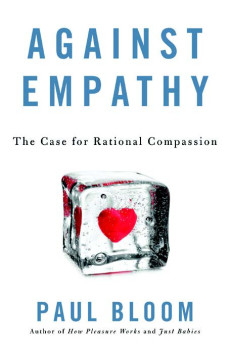A number of charities have started to use virtual reality technology as a fundraising tool. After donning a VR head-set that instantly transports them to a refugee camp in Lebanon, donors may be more inclined to contribute to humanitarian organizations supporting refugees. But Paul Bloom, a Yale University psychologist, is not impressed with what is being called an “empathy machine.” As he recently told NPR, empathy is “fatiguing. It leads to burnout. … The best therapists, the best doctors, the best philanthropists are people who don’t feel the suffering of others.”
Bloom expands on this argument in Against Empathy. He delivers his indictment in the breezy, intimate prose of the hip senior academic; his writing is studded with casual, comic parentheticals. But for all its informality, his critique is fierce. As he explains, he wants us to think about empathy the way we think about racism, as an ultimately pernicious mode of feeling.
In the book, Bloom takes pains to restrict his assault to a very particular definition of empathy. He uses the term to refer to “emotional empathy”—the act of feeling what you believe other people feel, distinguishing this from what is sometimes called “cognitive empathy,” or, more colloquially, the ability to imagine yourself in someone else’s shoes. Bloom’s beef isn’t with this latter trait, but in his rendering, it’s not always easy to tell the two apart.
Bloom marshals a wide range of findings from the fields of social psychology and neuroscience in service of his take-down of emotional empathy. For instance, he discusses the “identifiable victim effect,” which leads donors to give more when the targeted recipient is a specific single individual rather than a large, abstract group. He also questions the evolutionary basis of empathy and the research linking empathy to moral action: “Empathy is a spotlight focusing on certain people in the here and now. This makes us care more about them, but it leaves us insensitive to the long-term consequences of our acts and blind as well to the suffering of those we do not or cannot empathize with. Empathy is biased, pushing us in the direction of parochialism and racism.”
But at times, Bloom attributes too much immoral behavior to empathy. For example, he cites the empathy that white Southerners felt for the white victims of supposed African-American sexual predation as an important cause of racial violence. But much more of that violence was actually due to cold, calculated terrorism.
In contrast to empathy, Bloom favors “a more diff use compassion,” one founded on depersonalized, rational deliberation and the calculus of cost-benefit analysis. At several points, he holds up the effective altruism (EA) movement as his ideal, citing the movement’s founding theorist, ethicist Peter Singer, as inspiration. Seeking to do the most good, the EA movement urges donors to direct giving toward improving the lives of the world’s poorest. But i f some feel the tug of more parochial attachments and appreciate what Bloom calls “the intrinsic value of intimate relations” when considering their charitable obligations, the resistance to effective altruism is not always due to an excess of empathy. It also often involves deeply considered beliefs that can root our identities—and our moral commitments— in our local communities.
If Bloom’s definition of empathy at times feels too restricted, given all the significance he places on it, at other points he seems to prefer a more expansive definition, using the term to signify the reliance on “gut feelings and emotional responses to guide our judgments and behaviors.” Emotionalism becomes his target, and we can detect his frustration with the dominant strains in neuroscience and social psychology that maintain the primacy of the emotional, “hot” parts of the brain. “We can,” he insists, “override, deflect, and overrule our passions.”
Sure, but we should also recognize that our passions can play a constructive role in our moral life. The binary opposition between the head and the heart that Bloom sometimes sets up is the book’s weakest pillar. Certainly, many of the leaders of the EA movement would question this dichotomy and instead stress the compatibility of strong passions with rational deliberation. GiveDirectly, the charity that transfers cash directly to the global poor and is a favorite of the EA movement, has recently unveiled a version of the sponsorship system that allows donors to develop a personal connection with the specific individuals their gifts are helping. In many respects, empathy seems well aligned with effective altruism.
Bloom doesn’t necessarily deny this. He concedes that if empathy is not an absolute good, it is also not an absolute evil. He claims, though, that its costs outweigh its benefits. But for all his championing of cost-benefit analysis, this feels more like a gut calculation, and one that he never fully commits to. In fact, by the book’s end, he has trimmed his arguments’ sails considerably, arguing that empathy can be a “reliable and useful servant—but never a master.” Ultimately, Bloom’s own rhetorical strategies mirror this more sober, nuanced assessment. The ardent, unequivocal title and the occasionally overzealous argument jolt the reader and compel attention. But Bloom is careful to follow up with caveats and reasoned qualifications. This is, it turns out, a book of both the heart and the head.


